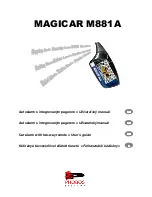
THIS SMOKE ALARM WILL NOT OPERATE WITHOUT A BATTERY INSTALLED.
PROPER BATTERY MUST BE INSTALLED IMMEDIATELY WHEN LOW
BATTERY SIGNAL IS GIVEN OR THE UNIT WILL FAIL. TEST WEEKLY. READ
AND FOLLOW ALL INSTRUCTIONS OR UNIT WILL NOT OPERATE PROPERLY.
FALSE ALARMS
The smoke alarm is designed to minimize false alarms. Smoking will not normally set off the alarm
unless smoke is blown directly into the smoke alarm. Combustion particles from cooking may set off
the alarm if the smoke alarm is located close to the kitchen cooking surface. Large quantities of
combustion particles are generated from spills or broiling.
If the smoke alarm does alarm, check for fires first. If a fire is discovered, get out and call the fire
department. If no fire is present, check to see if one of the reasons listed above may have caused
the alarm.
INSTALLATION
Your smoke alarm is designed for easy mounting on wall or ceiling. A complete mounting kit is
included with the smoke alarm. First, attach the mounting bracket on the wall or ceiling with the
screws provided. Second, push and turn the smoke alarm clockwise on the mounting bracket.
(Note: Your smoke alarm is equipped with a safety device which prevents mounting unless a battery
is installed. If your smoke alarm will not lock into the mounting bracket, check to make sure a battery
is installed.)
Early warning fire detection is best achieved by the installation of fire detection equipment in
all rooms and areas of the household as follows: A smoke alarm installed in each separate
sleeping area (in the vicinity of, but outside of, the bedrooms) and heat or smoke alarms in
living rooms, dining rooms, kitchens, hallways, attics, furnace rooms, closets, utility storage
rooms, basements and attached garages. Test the smoke alarm weekly to assure proper
operation.
Page 3
AVOID THESE LOCATIONS
•
the garage – products of combustion are present when you start your automobile.
•
near appliances or areas where normal combustion regularly occurs (kitchens, near furnaces,
gas hot water heaters). Use smoke alarms with Silence Control for these areas.
•
in areas with high humidity, like bathrooms or areas near dishwashers or washing machines.
Install at least 3 feet (0.9 meters) away from these areas.
•
in areas of turbulent air such as air returns or heating and cooling supply vents, smoke alarms
shall not be located where airflow prevents operation of the alarms.
•
in extremely dusty, dirty or insect-infested areas. Loose particles interfere with smoke alarm
operation.
•
in areas where temperature may fall below 40
0
F (4.4
0
C) or rise above 100
0
F (37.8
0
C).
•
closer than 1 foot (0.3m) from fluorescent lights, electrical "noise" and flickering may affect the
alarm's operation.
•
closer than 3 feet (0.9m) horizontal path from the tip of the blade of a ceiling suspended (paddle)
fan.
•
on a poorly insulated ceiling or exterior wall (mount smoke alarm on an inside wall).
OPERATION, TESTING & MAINTENANCE
OPERATION:
The smoke alarm is operating once the battery is connected. When products of
combustion are sensed, the unit sounds a loud alarm which continues until the air is cleared.
This alarm incorporates the internationally recognized horn signal for evacuation. During alarm
mode, the horn produces three short beeps followed by a two second pause and then repeats.
STANDBY CONDITION:
The red LED flashes once every 40-60 seconds to indicate the unit is
properly functioning.
LOCAL ALARM CONDITION:
The red LED flashes rapidly and the unit emits a loud, pulsating
alarm sound.
TESTING:
Test by pushing the test button on the smoke alarm cover until the alarm sounds, then
release. The alarm sounds if all electronic circuitry, horn and battery are working. The alarm may
continue to sound for up to 10 seconds after the button is released. If no alarm sounds, the unit may
have a defective battery or other failure. Test the smoke alarm weekly to assure proper operation.
























